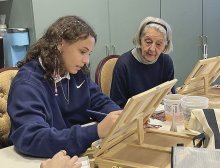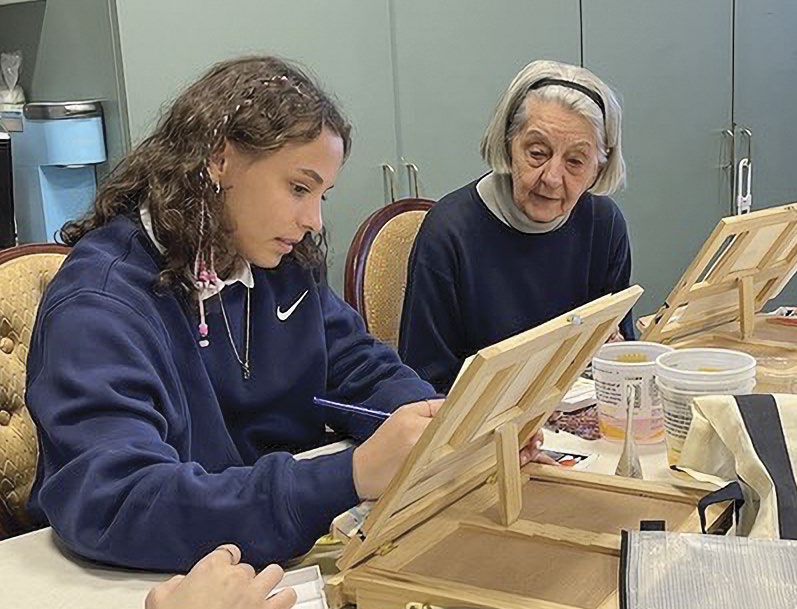
By Jen Donnalley, Director of CPG, and Austin Lehn, Assistant Director of CPG
When we embarked on planning a service program for our high school five years ago, our vision was for service to permeate every aspect of Upper School life. Building on the existing culture of service on Old Church Road, we aimed to integrate it into the lives of older students.
In those early days, we grappled with a crucial question: should we implement a service requirement, as is common in most high schools, or foster an expectation that all students would engage in this work? We were convinced that to nurture global citizens who are intrinsically motivated to address inequities, we had to take the less traveled path and establish an expectation rather than a requirement. We were fortunate to have the support of Adam Rohdie, who entrusted us with the decision, affirming, “You’re the experts—if this is what you believe will create the best program for our students, then that’s what we’ll do.” We believed that by making participation voluntary, students would be more inclined to pursue projects aligned with their interests and passions, which was precisely our aim.
With decades of engagement in community service and participation in volunteer events locally, nationally, and globally, we have personally observed the distinction between students genuinely invested in their service projects and those merely fulfilling hour quotas with a disengaged mindset. We knew we did not want to be a part of that type of program; we wanted students to choose projects they were genuinely passionate about and engaged in from the heart.
Nearly five years on, our approach has been successful. Our students aren’t merely tallying mandatory service hours; they are actively selecting and participating in projects meaningful to them and inspiring their peers and faculty to join them.
Service has become deeply ingrained in the culture of our school to the extent that it’s challenging to avoid. The overwhelming majority of students are engaged in some form of service. It’s woven into the curriculum, arts, athletic programs, clubs, student government, and Intersession.
Our ultimate goal is for service to continue to be a cornerstone of our alumni’s lives long after they graduate from Country Day. We hope they’ll follow in the footsteps of individuals like Caroline Simmons ’01, who became the mayor of Stamford, CT, or establish initiatives similar to Donovan Mitchell’s ’12 SpidaCares, or champion causes like Zach Berzolla ’11, working towards net-zero commercial buildings in Maryland by 2040. By instilling a service expectation in the GCDS Upper School, we believe we’re preparing our students to become catalysts for change and lead purposeful lives.
We see examples of community engagement everywhere in the Upper School.
ATHLETICS: Whether through friendly games with Abilis or fundraising events like Pack the Rink Night, our Athletics department wholeheartedly engages in service alongside their athletes.
STUDENT GOVERNMENT: The Class of 2025 spearheaded a Rise Against Hunger event, demonstrating a collective commitment to service by independently raising funds for the cause.
ARTS: GCDS musicians bring joy to local senior citizens, showcasing the power of music to uplift communities.
ACADEMICS: After studying “systems thinking” in Seminar class, 10th graders volunteer with and learn about the work of a local nonprofit tackling systemic issues such as housing, education, and legal systems.
INTERSESSION: As Dr. Ruoss says, Intersession is the Center for Public Good’s Super Bowl. This year, 87 Upper School students participated in CPG Intersessions (many more applied). Students designed and helped to run these Intersessions and came up with ideas that were better than anything we could have imagined after being in the business for 25 years. We collaborated with various community- based non-profits, including Greenwich Emergency Medical Services, Waterside School in Stamford, CT, and organizations like Abilis, which serves developmentally disabled individuals. This partnership extended to a dozen groups addressing food insecurity, such as Neighbor to Neighbor and Meals on Wheels, underlining the wide-reaching impact of the Intersession projects.
CLUBS: Various student groups serve children, the elderly, the special needs population, newly arrived immigrants, and/or those facing food insecurity. They work after school during their athletic “off-season,” sometimes on the weekends, and maybe even during lunch or their free block. And students are truly running them. They do everything from planning the sessions to emailing their members. These are our future leaders!











.JPG&command_2=resize&height_2=85)





.jpg&command_2=resize&height_2=85)




